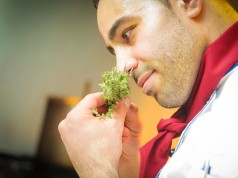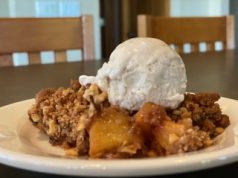Bonjour 24/680 followers!
We have been busy here at Epicurean Exchange! Last week we hosted cookbook author and friend of Epicurean Exchange, Georgeanne Brennan. We had 16 – 24/680 guests and a few others from the surrounding areas helping to prepare an incredible fall menu, including a classic Daube with fresh capes (porcini mushrooms). When we asked Georgeanne the difference between Boeuf Bourguignon and a Daube her reply: “first its from the South of France; the meat for a Daube are less tender cuts (and less expensive), and the meat is marinated in red wine, vegetables and aromatics for up to 12 hours before being cooked.”

According to New York Times Cooking, a classic Provencal beef daube, or slow-baked stew, is made with quantities of red wine, like the recipes that Julia Child often made in her house in Provence, La Pitchoune. The large amount of liquid makes a tender braise that can also be served as a sauce for pasta: penne, gnocchi and long noodles like tagliatelle are familiar in the region, which borders Italy on the east. Epicurean Exchange Culinary Travel visits Julia’s La Pitchoune every year during our Provence tour. This year’s tour is sold out, but we have room on our October 2020 tour!
Provencal Beef Daube
Slow-simmering and full of rich flavor, the daube – a wine-based stew- is a classic dish that has many variations. Daubes require the less tender cuts of beef that have gelatinous sinews and tendons that thicken and flavor the sauce. A fine, tender cut such as top sirloin will be wasted here, and its daube will the thin and pallid. Instead choose boneless chuck or a combination of boneless chuck and beef shank, which become meltingly tender and flavorful with slow cooking and contribute fully to the sauce’s construction. The traditional accompaniments are pasta and braised carrots, but polenta, gnocchi, or potatoes are also good.

4 pounds boneless beef chuck roast or a combination of boneless chuck and beef shank
2 yellow onions
3 carrots
8 fresh thyme branches, each about 6 inches long
3 fresh bay leaves, or 2 dried
1 fresh rosemary branch, about 6 inches long
2 teaspoon salt
2 tablespoons freshly ground black pepper
4 cloves garlic
1 orange zest strip, 4 inches long by ½ inch wide
1 bottle dry red wine such as a cote du Rhone, Zinfandel, or Burgundy

1/3 cup minced roulade (pancetta) or salt pork
2 tablespoons all-purpose flour
1 cup water
1 – pound fresh cèpes (porcini), halved, quartered or sliced, according to size or 2 ounces dried, some broken into 2 or 3 pieces, others left whole (brown cremini mushrooms can also be used)
1 pound wide, flat, pasta noodles, dried or fresh
½ to ¾ cup freshly grated Parmesan cheese
½ cup chopped fresh flat-leaf parsley
To Prepare the Marinade:
• Cut the beef chuck into 2 – 2 1/2-inch squares. Trim off and discard any large pieces of fat. If using beef shank, cut the meat from the bone in pieces as large as possible. Place the meat in a large enamel, glass, earthenware, or other nonreactive bowl. Quarter 1 of the onions and add the pieces to the meat along with the carrots, thyme, bay leaves, rosemary, 1 teaspoon of the salt, 1 tablespoon of the pepper, 2 cloves of the garlic, and the orange zest. Pour the wine over all the ingredients and turn to mix and immerse the ingredients. Cover and marinate in the refrigerator for at least 4 hours, but preferably overnight.
To Cook the Daube:
• Put the roulade or salt pork in a heavy-bottomed casserole or Dutch oven large enough to hold the marinating mixture. Place over medium-low heat and cook, stirring occasionally, until the fat is released, about 5 minutes. Discard the crisped bits.
• Dice the remaining onion and mince the remaining 2 garlic cloves and add to the fat. Sauté over medium heat until translucent, 3 to 5 minutes. Remove with a slotted spoon and set aside.
• Now, drain the meat and reserve the marinade. Pat the meat as dry as possible. Do not be alarmed by its purplish color, as the wine is responsible. Add the meat to the pot a few pieces at a time and sauté for about 5 minutes, turning them once or twice, browning them. Remove the pieces with a slotted spoon and continue until all the meat has been sautéed. When the last of the meat pieces have been removed, add the flour and cook it until it browns, stirring often.
• Raise the heat to high and slowly pour in the reserved marinade and all its ingredients. Deglaze the pan by scraping up any bits clinging to the bottom. Return the sautéed onion, garlic, meat, and any collected juices to the pan. Add the remaining 1 teaspoon salt and the remaining 1 or ½ tablespoon black pepper, and the water and bring almost to a boil. Reduce the heat to very low, cover with a tight-fitting lid, and simmer until the meat can be cut through with the edge of a spoon and the liquid has thickened, 2 ½ to 3 hours.
• Remove from the heat. Discard the carrots, herb branches, and onion quarters. Skim off some, but not all of the fat.
• Sauté the mushrooms in the remaining olive oil, and salt and pepper to taste. Turn several times; they should be lightly golden. Add them and their juices to the daube. (If using dried, soak them in a cup of water for 30 minutes before using, then strain, discarding any bits of dirt or grit.)
• Meanwhile, bring a large pot of salted water to a boil. Add the pasta, stir well, and cook until just tender. Drain.
• Put the pasta in a warmed serving bowl and ladle some of the sauce from the daube over it, adding more salt and pepper if desired, and topping with ¼ cup of the Parmesan cheese and the parsley. Put the daube in a serving bowl. Pass the remaining cheese at the table.
Serves 6 to 8















We just have to say that we can almost smell this one and – being incorrigible disciples of Chef Charlie – will be trying this one when our current abstention from meat wears out. May be soon. We’ll let you know how it turns out.
Sweet – I think I just found dinner for tomorrow night!!
Looks delicious!!!